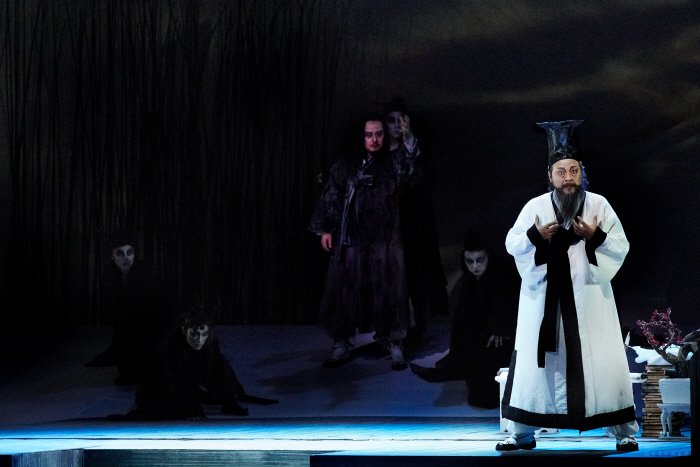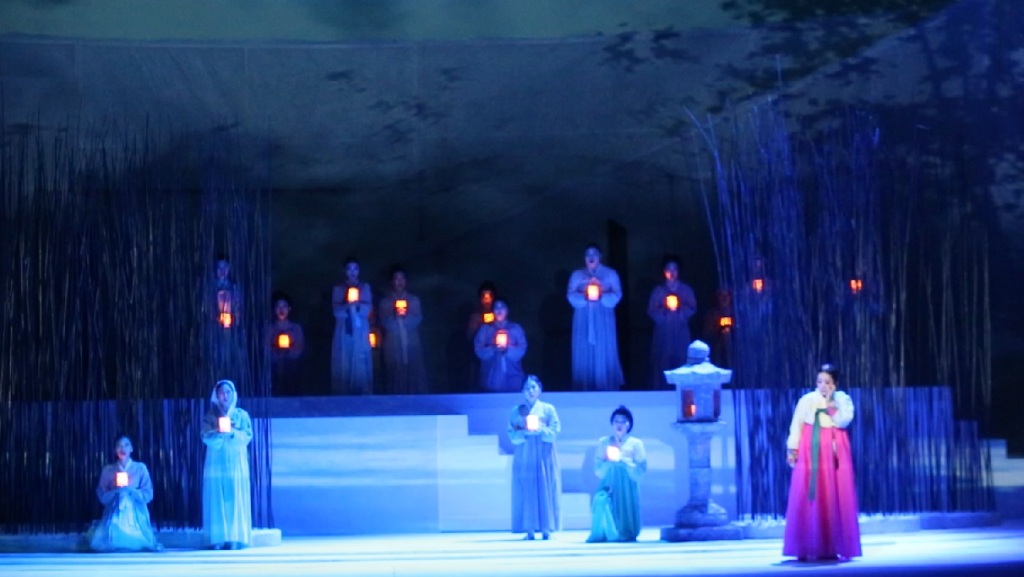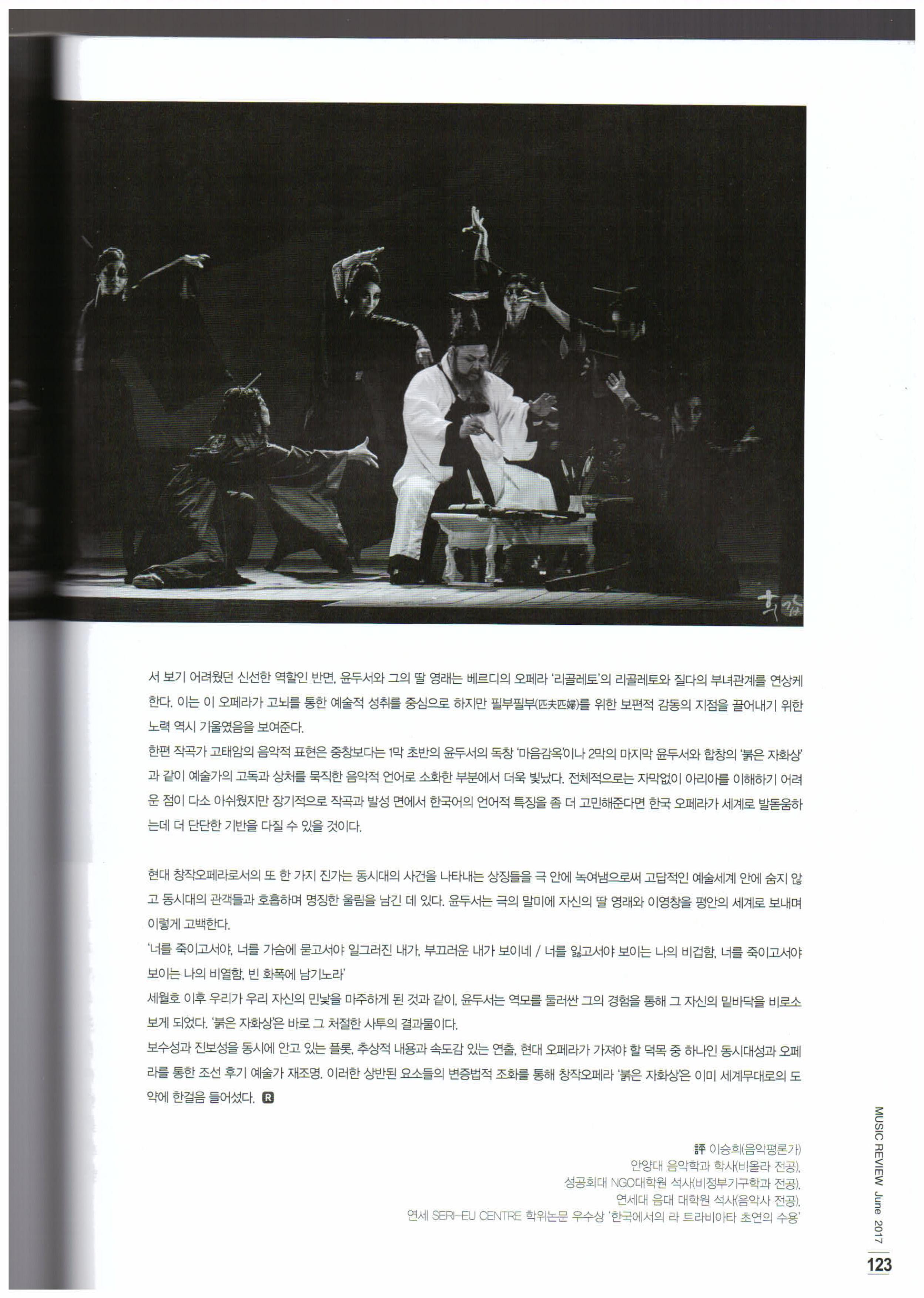Displayed Korean’s capability to make the opera
‘Self-portrait with red eyes’ created by Seoul Opera Ensemble
Haeorum Theater of the National Theater of Korea, Seoul on May 7

Get Below a Surface of The Artist Rather Than Showing the Historical Facts
An elderly painter holding his brush faces a sheet of hanji(韓紙), the traditional Korean paper. A paper once might be a playground as well as a base of artistic creation notwithstanding, it now becomes an object of dread. His name is GongJae(pseudonym- 恭齋) Yoon, DooSeo(윤두서, 尹斗緖, 1668-1715), one of the great painters of the late Joseon Dynasty. The opera focused on his later years, Self-Portrait with red eyes, was performed at Haeorum Theater of the National Theater of Korea from May 6 to 7.
Though operas created by Koreans had not been the successful genre which attracts the audience due to their clumsiness, this work funded by Support Creative Activities in Performing Art of Arts Council Korea as a prestigious work demonstrated that Korean’s capability to make opera has significantly improved.
Stage designs which emphasized the symbolistic and metaphorical representation inspired from Hanji using a revolving stage identified that this work ultimately intends to render the abstract quality. It was especially stimulating that this work visually expressed mental conflicts of the artist through the multifarious forms of the stage setting and spirits wearing black capes. The opera had the rapid change of scenes to avoid the abstruseness and boredom created by metaphorical contents. Also, the stage design with everything in miniature which displayed in the lobby provided stereoscopic visions for the audience after the performance.

The advancement of female character from one to three dimension
One of the virtues of this work is the way to deal with Widow Naju (나주댁, 羅州宅)/Night Spirit (흑야, 黑夜), the owner of public house and medium. Whereas the multitude of a female character has been a female saint or wicked woman, prey or femme fatale in the existing operas, Widow Naju/Night spirit is a hedonist as well as healer who has both the conviviality and bleakness.
On the other hand, the relationship between father who afflicted by a pang of conscience as he could not save his disciple, Yi, YoungChang (이영창) and his daughter who cannot forget her lover, Yi, Young-Chang proves this opera combines progressiveness, as mentioned above, with conservatism for the audience accustomed to the erstwhile operas. While Widow Naju/Night Spirit is the innovative and unprecedented female character, the relationship between Youn, DooSeo and his daughter, Young Rae, reminds the audience of Rigoletto and Gilda. This opera deals with an abstract theme about the artistic achievement after the painter groans in anguish, but also exerts an effort to have a universal appeal like paternal love which has been a cliché.
Musical expressions by Go TaeAm(고태암, composer) was better in <Prison of the heart- Yoon, DooSeo> at the beginning of Act1 and in <Self-portrait in Red- Chorus with Yoon, DooSeo> at the last part of Act2 than ensembles.
Though words of all forms of music including arias, ensembles, and recitative in the opera does not sound clear whereby the audience cannot understand it without Korean subtitles, Korean-language operas might have a solid foundation to win an international reputation if linguistic traits of Korean language are reflected in the composition and methods of vocalization.
Interaction with the audience by using many symbols which represent contemporary issues of Korea is another virtue of this opera. It decides to interact with the audience rather than hide in the world of highbrow art. Yoon, DooSeo confesses as he sees his daughter, YoungRae, and Yi, YoungChang off on their last journey:
After killing you,
After burying you in my heart,
I can see myself distorted, myself in shame.
After losing you, I can see my cowardice
After killing you, I can see my meanness
I leave them on the vacant canvas.

Yoon DooSeo ultimately reaches the nadir of his life through his experience being implicated in machination, just like Koreans faces their personae after The Sewol Ferry Disaster. The self-portrait created after his tragedy is the result of the desperate struggle for searching his true face.
The plot having both the operatic stereotype and the originality, the abstract topic and the fast-moving narrative, and the contemporariness especially required to the modern opera and rethinking the artist in the last Joseon dynasty. ‘Self-portrait with Red Eyes’ takes a step forward to the world stage through the dialectical balance between antithetical concepts.
Lee Seung-Hee (Music critic)
The June issue of Music Review
Rehearsal
Seoul Opera Ensemble- Opera seminar


 MusicReview (2017.6)-붉은 자화상
MusicReview (2017.6)-붉은 자화상
댓글 남기기